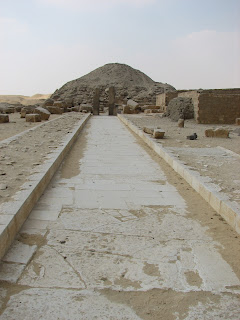
You're looking at the first pyramid built in Egypt. Before this point, royalty and nobility were buried in mastabas which would look like the bottom level of this step pyramid. About the 27th c. BC, King Djoser's chief architect, a guy named Imhotep, came up with the idea to stack mastabas on top of each other to create a six-step pyramid. Djoser's pyramid sits amongst the ruins of a large funerary complex, surrounded by a wall which featured a frieze of cobras. In the foreground of the photo, can you see a remnant of these cobras?
Saqqara, just south of Cairo, served as a burying ground for Memphis, which was the capital city of Egypt during the Old Kingdom and nobility were still being buried there in the New Kingdom after the capitol had moved to Thebes. It is the largest archaeological site in Egypt and covers about 7 km of desert and is littered with pyramids and mastabas. We were able to enter several of the mastabas and although we weren't allowed to take photos, our guide let me take a few when we were away from the crowds and it was light enough where I wouldn't have to use flash. All of the walls of these tombs were completely covered in reliefs depicting both symbolic scenes as well as scenes from daily life. The details were fascinating. There are people in boats pulling up nets with many different kinds of fish, boys wrestling and playing, butchers slaughtering cattle, marshes with frogs, birds, crocodiles, hippos, and grasshoppers, dwarves depicted as goldsmiths, as well as lots and lots of servants bearing food and drink for the deceased's ka or spirit. Some examples.....unfortunately I wasn't able to capture any pics of hippos. Those were my favorites. :)





One of the many aspects of pyramids which we were completely unaware of before we came to Egypt was that virtually every pyramid is associated with a complex of buildings which are so standard that archaeologists know to look for them. There is always the mortuary temple which is built against the east side of the pyramid where priests present prayers and offerings to sustain the king's ka. There is usually a smaller pyramid in the complex and there is virtually always a wall which encloses the two pyramids. There is also a valley temple. The valley temple is always located on the bank of a river which is how the body of the king was transported and the temple was used for the mummification process. A long causeway connects the valley temple with the entrance of the mortuary temple. This is why pyramids are in the desert but often just on the edge of cultivated land. I hope that makes sense. I'm sure I could figure out how to draw a layout of a pyramid complex on Photoshop and link it here but I'm such a horrible artist, I don't think it would clear things up much. :)
Anybahoo, the only surviving somewhat intact causeway in Egypt is in Saqqara, connecting the pyramid of Unas, a king in the 5th dynasty, with the ruins of its valley temple about 1 km away.
The causeway was walled and roofed at one time but there are only remnants left. I think they reconstructed some of the floor. Here you see the causeway with the pyramid in the background behind two pillars which I think was the entrance to the mortuary temple.

The hieroglyphs on one of the pillars indicating that it indeed belonged to King Unas.

There were parts of the wall still intact along the causeway which had reliefs on them. Here's one which depicts ships:

Another feature found in several pyramid complexes are boat-shaped pits. The ones found in Giza near the Great Pyramid actually contained wooden boats, purportedly to transport the king and family to the Land of the West. Here are some boat pits outside the pyramid of Unas but apparently no boats were found so maybe they were just symbolic?

Finally, I took a photo of the stars in the last remaining section of the causeway ceiling. It blows me away that there is still some blue coloring left after 3000 years! You'll have to click on the photo to open it in another window in order to see the stars. We only saw a small portion of what Saqqara has to offer and we're looking forward to going back to see more!

3 comments:
You explained the complex of pyramids very clearly and it makes perfect sense. Why was the smaller pyramid built though?
These are amazing photos!
Thanks, Wendi.
Those are great photos..the detail really shows up when you open them up. This sounds SOOO cool! We keep thinking, "Should we visit?"
Jen
Oops forgot to answer your question, Dee! My book tells me that they're not sure what the smaller subsidiary pyramid was used for. There are often smaller pyramids in the complex which were often used for the burials of the Pharoah's wives and family.
Post a Comment